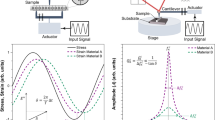Abstract
Films made of nanofibrillated cellulose (NFC) are most interesting for use in packaging applications. However, in order to understand the film-forming capabilities of NFC and their properties, new advanced methods for characterizing the different scales of the structures are necessary. In this study, we perform a comprehensive characterisation of NFC-films, based on desktop scanner analysis, scanning electron microscopy in backscatter electron imaging mode (SEM-BEI), laser profilometry (LP) and field-emission scanning electron microscopy in secondary electron imaging mode (FE-SEM-SEI). Objective quantification is performed for assessing the (i) film thicknesses, (ii) fibril diameters and (iii) fibril orientations, based on computer-assisted electron microscopy. The most frequent fibril diameter is 20–30 nm in diameter. A method for acquiring FE-SEM images of NFC surfaces without a conductive metallic layer is introduced. Having appropriate characterisation tools, the structural and mechanical properties of the films upon moisture were quantified.











Similar content being viewed by others
References
Abe K, Iwamoto S, Yano H (2007) Obtaining cellulose nanofibers with a uniform width of 15 nm from wood. Biomacromolecules 8:3276–3278
Abramoff MD, Magelhaes PJ, Ram SJ (2004) Image processing with ImageJ. Biophotonics int 11(7):36–42
Ahola S, Salmi J, Johansson L-S, Laine J, Österberg M (2008) Model films from native cellulose nanofibrils, preparation, swelling, and surface interactions. Biomacromolecules 9:1273–1282
Andresen M, Johansson L-S, Tanem BS, Stenius P (2006) Properties and characterization of hydrophobized microfibrilated cellulose. Cellulose 13:665–667
Antoine C (2007) Wire marking and its effect upon print-through perception of newsprints. Appita J 60(3):196–203
Bockus S (2006) A study of the microstructure and mechanical properties of continuously cast iron products. Metalurgija 45(4):287–290
Chinga G, Solheim O, Mörseburg K (2007a) Cross-sectional dimensions of fiber and pore networks based on Euclidean distance maps. Nordic Pulp Paper Res J 22(4):500–507
Chinga G, Johnsen PO, Dougherty R, Lunden-Berli E, Walter J (2007b) Quantification of the 3D microstructure of SC surfaces. J Microscopy 227(3):254–265
Eriksen Ø, Syverud K, Gregersen Ø (2008) The use of microfibrillated cellulose produced from kraft pulp as a strength enhancer in TMP paper. Nord Pulp Paper Res J 23(3):299–304
Fukuzumi H, Saito T, Iwata T, Kumamoto Y, Isogai A (2009) Transparent and high gas barrier films of cellulose nanofibers prepared by TEMPO-mediated oxidation. Biomacromolecules 10:162–165
Gonzalez R, Woods RE (1993) Digital image processing. Addison–Wesley, USA
Henriksson M, Berglund LA, Isaksson P, Lindström T, Nishino T (2008) Cellulose nanopaper structures of high toughness. Biomacromolecules 9:1579–1585
I’Anson S (1995) Identification of periodic marks in paper and board by image analysis using two-dimensional fast Fourier transforms. Tappi J 78(3):113–119
Iwamoto S, Abe K, Yano H (2008) The effect of hemicelluloses on wood pulp nanofibrillation and nanofiber network characteristics. Biomacromolecules 9:1022–1026
Meredith R (1956) The mechanical properties of textile fibres. North-Holland, Amsterdam
Mörseburg K, Chinga-Carrasco G (2009) Assessing the combined benefits of clay and nanofibrillated cellulose in layered TMP-based sheets. Cellulose. doi:10.1007/s10570-009-9290-4
Pääkkö M, Ankefors M, Kosonen H, Nykänen A, Ahola S, Österberg M, Ruokolainen J, Laine J, Larsson PT, Ikkala O, Lindström T (2007) Enzymatic hydrolysis combined with mechanical shearing and high-pressure homogenization for nanoscale cellulose fibrils and strong gels. Biomacromolecules 8:1934–1941
Rasband WS (1997) ImageJ, U. S. National Institutes of Health, Bethesda, Maryland, USA. http://rsb.info.nih.gov/ij/
Saito T, Nishiyama Y, Putaux JL, Vignon M, Isogai A (2006) Homogeneous suspensions of individualized microfibrils from TEMPO-catalyzed oxidation of native cellulose. Biomacromolecules 7(6):1687–1691
Syverud K, Stenius P (2009) Strength and barrier properties of MFC films. Cellulose 16(1):75–85
Turbak AF, Snyder FW, Sandberg KR (1983) Microfibrillated cellulose, a new cellulose product: properties, uses, and commercial potential. J Appl Polym Sci Appl Polym Symp 37:815–827
Wågberg L, Decher G, Norgren M, Lindström T, Ankefors M, Axnäs K (2008) The build-up of polyelectrolyte multilayers of microfibrillated cellulose and cationic polyelectrolytes. Langmuir 24:784–795
Yano H, Nakahara S (2004) Bio-composites produced from plant microfiber bundles with a nanometer unit web-like network. J Mater Sci 39:1635–1638
Acknowledgements
The authors thank Per Olav Johnsen (PFI) for skilful study in the image acquisition of some of the FE-SEM images. Professor Jarle Hjelen (Department of Materials Science and Engineering, NTNU) is thanked for facilitating the FE-SEM facilities applied in this study.
Author information
Authors and Affiliations
Corresponding author
Rights and permissions
About this article
Cite this article
Chinga-Carrasco, G., Syverud, K. Computer-assisted quantification of the multi-scale structure of films made of nanofibrillated cellulose. J Nanopart Res 12, 841–851 (2010). https://doi.org/10.1007/s11051-009-9710-2
Received:
Accepted:
Published:
Issue Date:
DOI: https://doi.org/10.1007/s11051-009-9710-2




